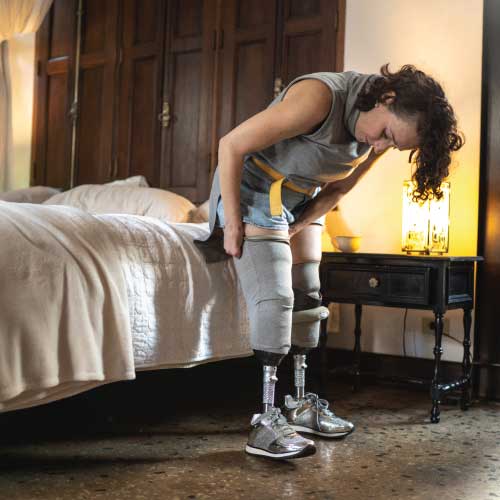Why Running Prosthetic Legs Need to Be Longer than Biological Legs
Running prosthetic legs are often a topic of discussion in the sports world, as seen in the case of Paralympian Blake Leeper, whose legs were deemed too long for his physique in the 2021 Tokyo Olympics. A study has been conducted to examine the mechanics of running prosthetic legs and to determine whether they should be shorter, longer, or equal in length to the biological leg.

Running-specific prosthetic legs
Prosthetic legs designed for running are made of carbon fiber and attached to a prosthetic socket. During the running stance phase, these prostheses imitate the spring-like behavior of natural legs.
However, unlike biological feet and ankles, running prostheses cannot actively plantar- or dorsi-flex while running. The only way prostheses can achieve this is by lengthening them, but athletes' prosthetic legs cannot be actively extended while running.
The height of a single-leg below-knee amputee's prosthetic leg is determined by their hip height while running. Therefore, an athlete's unloaded prosthetic leg should typically be 3% to 8% taller than their biological leg length while standing. Sanctioned athletic competitions do not limit the prosthetic leg height of athletes with single-leg below-knee amputations. However, athletes with double-leg amputations, such as Leeper, must adhere to strict height regulations.
Researchers aimed to establish the appropriate length of a standing prosthetic leg to achieve the same running leg length as a biological leg since identical lengths do not result in equal running lengths.
The study
The researchers recruited 11 non-amputee athletes, ten athletes with single-leg below-knee amputation, and five athletes with double-leg below-knee amputation for the study. The athletes with amputations were fitted with Ottobock's 1E90 Sprinter prosthetic leg.
The researchers conducted speed tests on study participants and found that those with single-leg below-knee limb loss had shorter running prosthetic leg lengths at mid-stance and take-off.
Interestingly, their standing prosthetic leg lengths were 2.4cm longer than their biological leg lengths. To achieve equivalent running leg length across different speeds at touchdown and take-off, athletes with single-leg below-knee limb loss should adjust their running prosthetic legs' height to be 2.8% to 4.5% longer than their biological leg lengths when standing.
Pros and cons of MASH
These findings suggest that MASH (measured allowable standing height) regulations for athletes with double-leg below-knee amputation may not result in equivalent running prosthetic leg lengths compared to biological leg lengths.
The researchers identified that one factor contributing to the length difference at mid-stance and take-off is the stiffness of the prosthetic leg, which can be 3.6% to 12% less stiff than a biological leg when running at 5-6m/s. Additionally, a shorter prosthetic leg length at take-off may reflect the inability to plantar-flex while running.
According to the researchers, achieving identical running leg lengths between a prosthetic and a biological leg is possible. This can be done by increasing the stiffness or height of the prosthetic leg. However, running with stiffer prosthetic legs may increase the risk of injury and impair performance.
Currently, no athletics regulations limit the biological leg lengths of non-amputee athletes or the prosthetic leg length of athletes with single-leg below-knee limb loss. However, athletes with double-leg below-knee amputations must adjust their prosthetic leg height to ensure they stay within their presumed MASH to compete in sanctioned athletics events.
The MASH method uses body segment measurements and data from non-amputee populations to estimate the height of an athlete standing barefoot. However, this method has limitations and potential biases, as running leg length may not always be proportional to standing leg length.
Furthermore, according to the MASH rule, athletes with double-leg below-knee amputations are often forced to run with shorter leg lengths than their biological dimensions.
In sanctioned athletics events, non-amputee athletes typically wear shoes with midsole heights of no more than 2 cm. To ensure that athletes with double-leg below-knee amputations can compete with running leg lengths equivalent to non-amputee athletes, researchers propose increasing their prosthetic leg height by 2.1% to 3.9% of their presumed standing biological leg lengths based on running speed and then adding 2.0 cm to account for footwear midsole height.
The bottom line
For athletes with single- and double-leg below-knee amputation, their prosthetic leg becomes shorter than their biological leg during running. But the former can achieve similar running leg lengths during touchdown and take-off by setting their prosthetic leg height at least 3.4% longer than their biological leg. The researchers also noted that they should include footwear sole height of less than or equal to 2.0 cm to be comparable to non-amputee runners.
The researchers suggest that policymakers should consider specific biomechanics when creating athletics regulations based on the findings of this study. Until then, under current regulations, athletes with double-leg limb loss must run at shorter than assumed heights.











































































